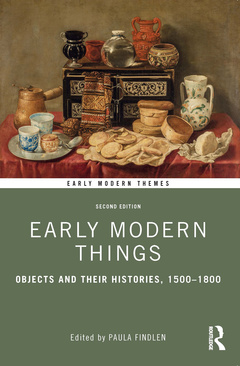Early Modern Things (2nd Ed.) Objects and their Histories, 1500-1800 Early Modern Themes Series
Coordonnateur : Findlen Paula

Early Modern Things supplies fresh and provocative insights into how objects ? ordinary and extraordinary, secular and sacred, natural and man-made ? came to define some of the key developments of the early modern world.
Now in its second edition, this book taps a rich vein of recent scholarship to explore a variety of approaches to the material culture of the early modern world (c. 1500?1800). Divided into seven parts, the book explores the ambiguity of things, representing things, making things, encountering things, empires of things, consuming things, and the power of things. This edition includes a new preface and three new essays on ?encountering things? to enrich the volume. These look at cabinets of curiosities, American pearls, and the material culture of West Central Africa. Spanning across the early modern world from Ming dynasty China and Tokugawa Japan to Siberia and Georgian England, from the Kingdom of the Kongo and the Ottoman Empire to the Caribbean and the Spanish Americas, the authors provide a generous set of examples in how to study the circulation, use, consumption, and, most fundamentally, the nature of things themselves.
Drawing on a broad range of disciplinary perspectives and lavishly illustrated, this updated edition of Early Modern Things is essential reading for all those interested in the early modern world and the history of material culture.
Preface to the second edition: early modern things revisited Introduction: Early modern things: objects in motion, 1500–1800 Part I: The ambiguity of things 1.Surface Ttnsion: objectifying ginseng in Chinese early modernity 2. Going to the birds: animals as things and beings in early modernity 3. The restless clock Part II: Representing things 4. Stil-Staende Dingen: picturing objects in the Dutch Golden Age 5. 'Things seen and unseen': the material culture of early modern inventories and their representation of domestic interiors 6. Costume and character in the Ottoman Empire: dress as social agent in Nicolay’s Navigations Part III: Making things 7. Making things: techniques and books in early modern Europe 8. Capricious demands: artisanal goods, business strategies, and consumer behavior in seventeenth-century Florence Part IV: Encountering things 9. Catalogical encounters: worldmaking in early modern cabinets of curiosities 10. Unruly objects: baroque fantasies and early modern realities 11. The taste of others: finery, the slave trade, and Africa’s place in the traffic in early modern things Part V: Empires of things 12. Locating rhubarb: early modernity's relevant obscurity 13. The world in a shilling: silver coins and the challenge of political economy in the early modern Atlantic world 14. Anatolian timber and Egyptian grain: things that made the Ottoman Empire Part VI: Consuming things 15. The Tokugawa storehouse: Ieyasu’s encounters with things 16. Porcelain for the poor: the material culture of tea and coffee consumption in eighteenth-century Amsterdam 17. Fashioning difference in Georgian England: furniture for him and for her Epilogue: the power of things 18. Denaturalizing things: a comment 19. Something new: a comment 20. Identities through things: a comment
Paula Findlen is Ubaldo Pierotti Professor of Italian History and Director of the Suppes Center for the History and Philosophy of Science and Technology at Stanford University, USA. Her previous works include Possessing Nature: Museums, Collecting, and Scientific Culture in Early Modern Italy (1994), and, most recently Empires of Knowledge: Scientific Networks in the Early Modern World (2019), Leonardo’s Library (2019), and The Renaissance of Letters (2020). She is a Fellow of the American Academy of Arts and Sciences.
Date de parution : 03-2021
15.6x23.4 cm
Date de parution : 03-2021
15.6x23.4 cm
Thème d’Early Modern Things :
Mots-clés :
Wall Hangings; Vice Versa; early; East Indies; modern; Germanisches Nationalmuseum; material culture; Muslim World; objects; Palissy; history; Oil On Canvas; circulation; Chandra Mukerji; consumption; Early Modern; Probate Inventories; empire; Willem Kalf; Ming dynasty China; Early Modern Material Culture; Georgian England; Religious Turk; Ottoman Egypt; Caffeinated Beverage; Spanish America; Early Modern Economic; Ottoman empire; Wenzel Jamnitzer; Early modern world; Southwestern Anatolia; Dutch golden age; Pieter Claesz; West central Africa; Pope Paul III; Staatliche Kunsthalle; Holy Roman Emperor Rudolf II; John Hull; Abraham Van Beyeren; Chinese Rhubarb; Rhubarb Root



